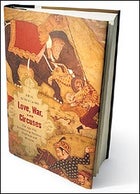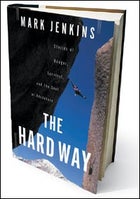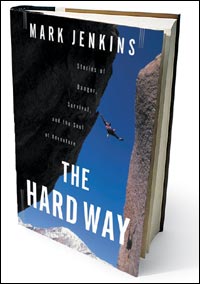Love, War, and Circuses


The Age-Old Relationship Between Elephants and Humans
BY ERIC SCIGLIANO
(Houghton Mifflin, $24)
THERE ARE LOTS of elephant books out there, ranging from the cute to the clinical, but Eric Scigliano’s is the first to take a careful look at the human-elephant relationship throughout history, whose benefits have been tragically one-sided. Scigliano contends that elephants may have played a crucial role in our evolution, serving as something like “midwives, or at least nursemaids” by uprooting forests in Africa until they became the vast grasslands where glorified primates began running amok. From Homer’s mythical one-eyed Cyclops, probably inspired by the enormous nasal cavities in elephant skulls, through Hannibal’s badass street-fighting pachyderms, Scigliano makes his way to perhaps the most disturbing period of all: now. His evenhanded documentation of the animals’ fate in zoos and circuses—where handlers mete out stomach-turning beatings to maintain dominion over their potentially lethal charges—inevitably leads to a humane conclusion: “The thrill of seeing elephants in their world, even from a distance, far surpasses the thrill of seeing them close-up in ours.”
—CAROLINE FRASER
Beyond the Deep
The Deadly Descent into the World’s Most Treacherous Cave
BY WILLIAM STONE AND BARBARA AM ENDE, WITH MONTE PAULSEN
(Warner Books, $27)
CAVERS MAY BE a strange breed, but Bill Stone stands apart as one of the most obsessed moles around. After a 1984 push into the Sistema Huautla—a tunnel complex of deep, underground rivers and flooded chambers in southeastern Mexico that is considered one of the most treacherous labyrinths in the world—Stone spent ten years inventing his own device for recycling exhaled air so he could dive past Huautla’s deepest sump. In Beyond the Deep, the story of their 1994 expedition to Huautla with a team of five elite cavers, Stone and dive partner Barbara am Ende admit that things didn’t exactly go swimmingly. The trip began six weeks behind schedule, which put them perilously close to the rainy season, when tunnels flood and cavers drown. Ian Rolland, one of their best divers, suffered insulin shock in a shallow pool some 4,300 feet below ground and died. The remaining four divers, nursing resentments over Stone’s leadership, quit the team. Stone persevered, if only because he had nothing left to lose. “i’ve lost my wife, my house, my money, all for this project,” he writes with characteristic bluster. “This is my chance, maybe my only chance. I’m going to push this cave to the bitter end.” Several weeks later he did, in a glorious final dive with am Ende that marked Huautla, at the time, as the longest—and fifth-deepest—cave in the world.
—BRUCE BARCOTT
On The Water
Discovering America in a Rowboat
BY NATHANIEL STONE
(Broadway Books, $22)
NATHANIEL STONE’S debut book opens with a brilliant conceit: Imagine the eastern half of the United States as an island. Then row around it, solo, in a 17-foot scull. “When I was perhaps ten,” writes Stone, publisher of a newspaper in Zuni, New Mexico, “while studying the Mississippi River, the Great Lakes and their outlet down the St. Lawrence to the sea, it occurred to me that the right combination of blue watery veins on the…map might provide a narrow yet unbroken channel between the North Atlantic and the Gulf of Mexico.” In 1999, armed with a few dry bags of supplies, Stone pushed off from a Brooklyn dock into the East River, bound for New Orleans by way of the Hudson River, the Erie Canal, Lake Erie, a nine-mile portage, the Allegheny River, the Ohio, and the mighty Mississippi. Surviving on equal parts pluck and cheap peanut butter, Stone proved the route’s feasibility—and then some—swinging around Florida and rowing the Atlantic back up to the tip of Maine, ten months and 6,000 miles later. Along the way he plays a sort of riverine William Least Heat-Moon, relying on serendipity and the kindness of strangers. Like Stone himself, readers will come away with an appreciation for the simplicity of a waterborne existence, for pulling the oars and defining a life, he writes, “through rowing.”
—B.B.
Antipode
Seasons with the Extraordinary Wildlife and Culture of Madagascar
BY HEATHER E. HEYING
(St. Martin’s Press, $26)
FIRST AS A TOURIST, then as a fledgling field biologist studying the poisonous frogs of Madagascar, Heather E. Heying travels to and from the island-nation off the east coast of Africa, learning not only to observe, but to be observed. In a country where no one can pronounce her name (she’s known there as “Erika,” from the scientific name for plants in the heather family), Heying quickly discovers the discomforts of being vazaha, a foreigner, whose mere presence occasions shouts of astonishment from the local populace. Just finding the right spot to study what she calls her “charismatic mesofauna” becomes a nightmare of red tape and logistics, complicated by an unprovoked attack from a brown lemur. Since the days of Leakey and Goodall, field memoirs have become commonplace, but Heying’s story—in which she’s transformed from a privileged American college kid to a scientist in love with Malagasy ways, hardships and all—is uncommonly well told, a happy immersion in the lives of “fisher people with mangoes…brightly colored frogs courting and singing…the ruffed lemurs cackling as the sun warmed their furry bellies high in the trees.”
—C.F.
FROM OUR PAGES
“Wanderlust is incurable,” writes ���ϳԹ���‘s Hard Way columnist Mark Jenkins in the prologue to his new book, The Hard Way (Simon & Schuster, $24), a collection of magazine essays on his far-flung, danger-defying adventures around the globe. Whether he’s writing about a solo ascent of Bolivia’s 19,974-foot Huayna Potosí or a forbidden trek to Tibet’s holiest lake, Jenkins’s extraordinary tales are sure to give readers a permanent case of travel fever.
Also new in stores: ���ϳԹ��� correspondent Tim Zimmermann’s The Race (Houghton Mifflin, $25), an account of extreme sailing’s nonstop, around-the-world speed contest on high-tech catamarans. The book chronicles the stories of go-for-broke skippers and their crews who risked it all for a place in the record books.

